International Business Report: E-commerce and Cultural Analysis
VerifiedAdded on 2022/10/19
|12
|2679
|4
Report
AI Summary
This report provides a comprehensive analysis of two key international business topics: e-commerce in Indonesia and the impact of cultural differences on international business, specifically focusing on India. The report examines the rapid growth of e-commerce in Indonesia, driven by increased mobile usage and social media adoption, while also highlighting challenges such as logistical issues, internet speed limitations, and low adoption of cashless payment systems. It explores the evolution of e-commerce, including the rise of both formal e-tailing and informal commerce, and discusses the implications for multinational enterprises (MNEs). Furthermore, the report delves into the cultural differences between India and other countries, including time management, workplace relationships, and hierarchical structures, and their effects on international business operations. The report examines potential consequences for MNEs operating in India, emphasizing the need for adaptability and understanding of local cultural norms to ensure successful global business strategies. The analysis underscores the importance of adapting business practices to local contexts for success in the global market.

Paraphrase This Document
Need a fresh take? Get an instant paraphrase of this document with our AI Paraphraser

Table of content
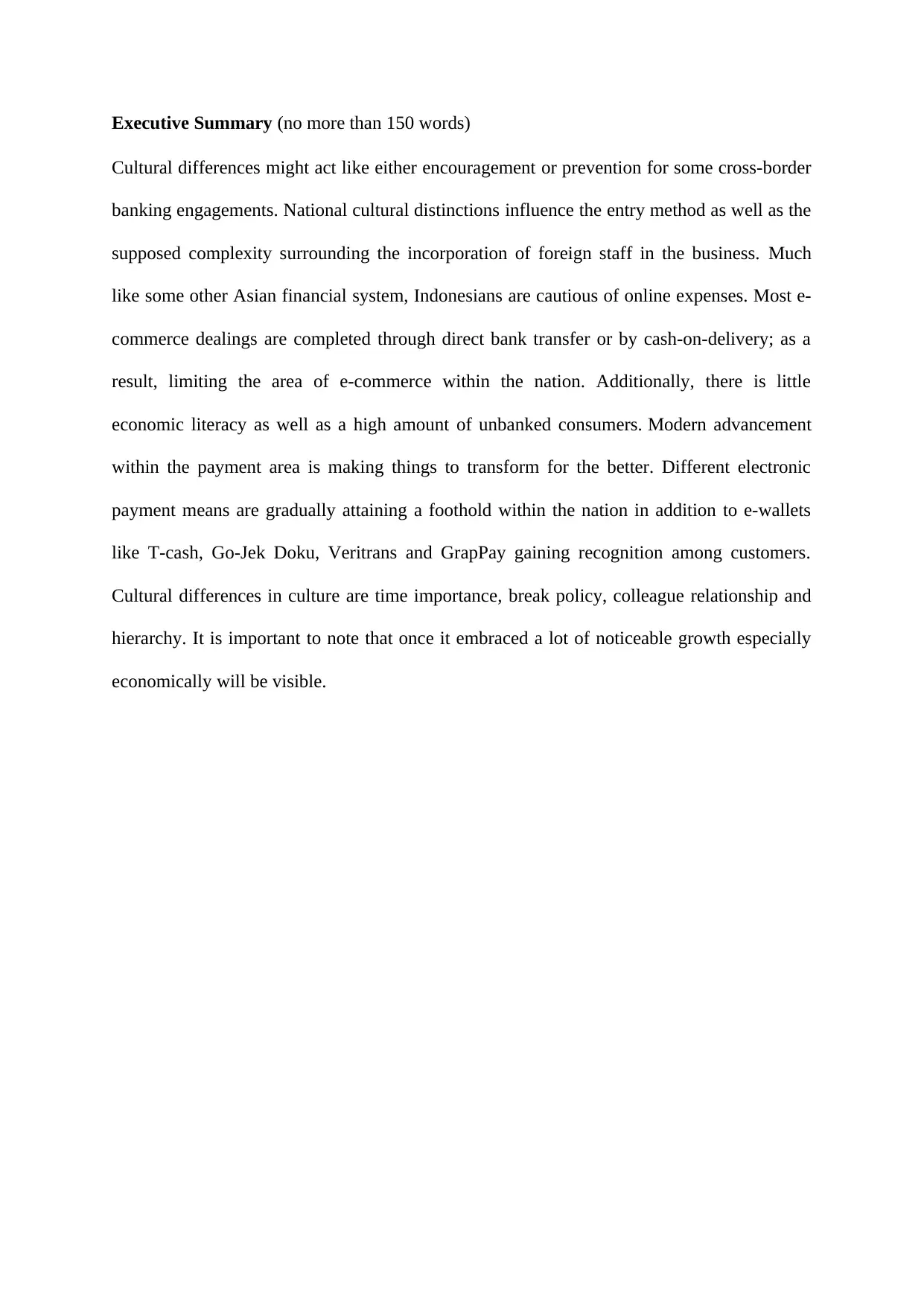
Executive Summary (no more than 150 words)
Cultural differences might act like either encouragement or prevention for some cross-border
banking engagements. National cultural distinctions influence the entry method as well as the
supposed complexity surrounding the incorporation of foreign staff in the business. Much
like some other Asian financial system, Indonesians are cautious of online expenses. Most e-
commerce dealings are completed through direct bank transfer or by cash-on-delivery; as a
result, limiting the area of e-commerce within the nation. Additionally, there is little
economic literacy as well as a high amount of unbanked consumers. Modern advancement
within the payment area is making things to transform for the better. Different electronic
payment means are gradually attaining a foothold within the nation in addition to e-wallets
like T-cash, Go-Jek Doku, Veritrans and GrapPay gaining recognition among customers.
Cultural differences in culture are time importance, break policy, colleague relationship and
hierarchy. It is important to note that once it embraced a lot of noticeable growth especially
economically will be visible.
Cultural differences might act like either encouragement or prevention for some cross-border
banking engagements. National cultural distinctions influence the entry method as well as the
supposed complexity surrounding the incorporation of foreign staff in the business. Much
like some other Asian financial system, Indonesians are cautious of online expenses. Most e-
commerce dealings are completed through direct bank transfer or by cash-on-delivery; as a
result, limiting the area of e-commerce within the nation. Additionally, there is little
economic literacy as well as a high amount of unbanked consumers. Modern advancement
within the payment area is making things to transform for the better. Different electronic
payment means are gradually attaining a foothold within the nation in addition to e-wallets
like T-cash, Go-Jek Doku, Veritrans and GrapPay gaining recognition among customers.
Cultural differences in culture are time importance, break policy, colleague relationship and
hierarchy. It is important to note that once it embraced a lot of noticeable growth especially
economically will be visible.
⊘ This is a preview!⊘
Do you want full access?
Subscribe today to unlock all pages.

Trusted by 1+ million students worldwide

Introduction(260 words)
In this report, we will be discussing our group’s analysis of two international business topics t
hat happened in a country. The subjects covered are e-commerce in the country, and the diffe
In this report, we will be discussing our group’s analysis of two international business topics t
hat happened in a country. The subjects covered are e-commerce in the country, and the diffe
Paraphrase This Document
Need a fresh take? Get an instant paraphrase of this document with our AI Paraphraser
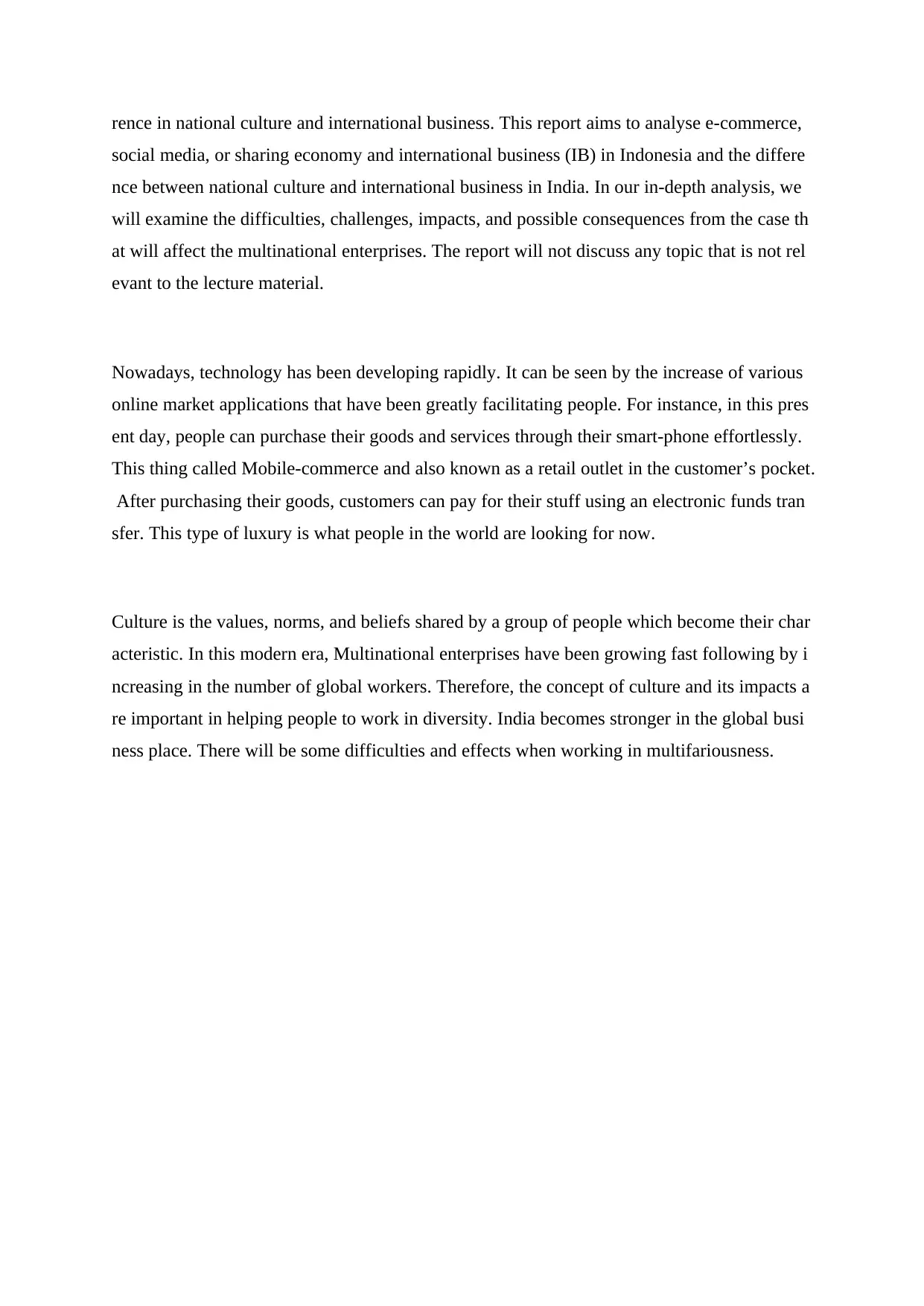
rence in national culture and international business. This report aims to analyse e-commerce,
social media, or sharing economy and international business (IB) in Indonesia and the differe
nce between national culture and international business in India. In our in-depth analysis, we
will examine the difficulties, challenges, impacts, and possible consequences from the case th
at will affect the multinational enterprises. The report will not discuss any topic that is not rel
evant to the lecture material.
Nowadays, technology has been developing rapidly. It can be seen by the increase of various
online market applications that have been greatly facilitating people. For instance, in this pres
ent day, people can purchase their goods and services through their smart-phone effortlessly.
This thing called Mobile-commerce and also known as a retail outlet in the customer’s pocket.
After purchasing their goods, customers can pay for their stuff using an electronic funds tran
sfer. This type of luxury is what people in the world are looking for now.
Culture is the values, norms, and beliefs shared by a group of people which become their char
acteristic. In this modern era, Multinational enterprises have been growing fast following by i
ncreasing in the number of global workers. Therefore, the concept of culture and its impacts a
re important in helping people to work in diversity. India becomes stronger in the global busi
ness place. There will be some difficulties and effects when working in multifariousness.
social media, or sharing economy and international business (IB) in Indonesia and the differe
nce between national culture and international business in India. In our in-depth analysis, we
will examine the difficulties, challenges, impacts, and possible consequences from the case th
at will affect the multinational enterprises. The report will not discuss any topic that is not rel
evant to the lecture material.
Nowadays, technology has been developing rapidly. It can be seen by the increase of various
online market applications that have been greatly facilitating people. For instance, in this pres
ent day, people can purchase their goods and services through their smart-phone effortlessly.
This thing called Mobile-commerce and also known as a retail outlet in the customer’s pocket.
After purchasing their goods, customers can pay for their stuff using an electronic funds tran
sfer. This type of luxury is what people in the world are looking for now.
Culture is the values, norms, and beliefs shared by a group of people which become their char
acteristic. In this modern era, Multinational enterprises have been growing fast following by i
ncreasing in the number of global workers. Therefore, the concept of culture and its impacts a
re important in helping people to work in diversity. India becomes stronger in the global busi
ness place. There will be some difficulties and effects when working in multifariousness.
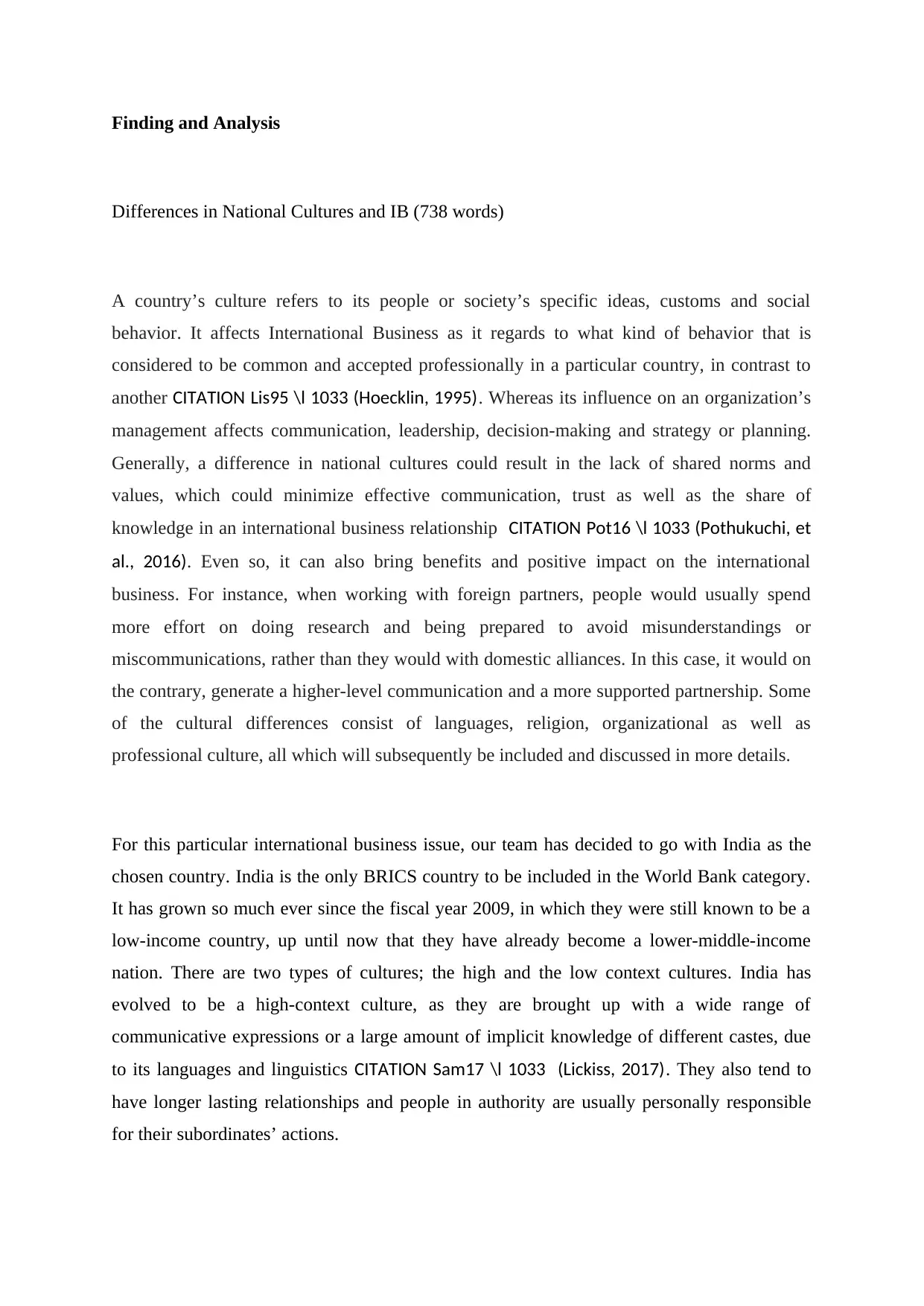
Finding and Analysis
Differences in National Cultures and IB (738 words)
A country’s culture refers to its people or society’s specific ideas, customs and social
behavior. It affects International Business as it regards to what kind of behavior that is
considered to be common and accepted professionally in a particular country, in contrast to
another CITATION Lis95 \l 1033 (Hoecklin, 1995). Whereas its influence on an organization’s
management affects communication, leadership, decision-making and strategy or planning.
Generally, a difference in national cultures could result in the lack of shared norms and
values, which could minimize effective communication, trust as well as the share of
knowledge in an international business relationship CITATION Pot16 \l 1033 (Pothukuchi, et
al., 2016). Even so, it can also bring benefits and positive impact on the international
business. For instance, when working with foreign partners, people would usually spend
more effort on doing research and being prepared to avoid misunderstandings or
miscommunications, rather than they would with domestic alliances. In this case, it would on
the contrary, generate a higher-level communication and a more supported partnership. Some
of the cultural differences consist of languages, religion, organizational as well as
professional culture, all which will subsequently be included and discussed in more details.
For this particular international business issue, our team has decided to go with India as the
chosen country. India is the only BRICS country to be included in the World Bank category.
It has grown so much ever since the fiscal year 2009, in which they were still known to be a
low-income country, up until now that they have already become a lower-middle-income
nation. There are two types of cultures; the high and the low context cultures. India has
evolved to be a high-context culture, as they are brought up with a wide range of
communicative expressions or a large amount of implicit knowledge of different castes, due
to its languages and linguistics CITATION Sam17 \l 1033 (Lickiss, 2017). They also tend to
have longer lasting relationships and people in authority are usually personally responsible
for their subordinates’ actions.
Differences in National Cultures and IB (738 words)
A country’s culture refers to its people or society’s specific ideas, customs and social
behavior. It affects International Business as it regards to what kind of behavior that is
considered to be common and accepted professionally in a particular country, in contrast to
another CITATION Lis95 \l 1033 (Hoecklin, 1995). Whereas its influence on an organization’s
management affects communication, leadership, decision-making and strategy or planning.
Generally, a difference in national cultures could result in the lack of shared norms and
values, which could minimize effective communication, trust as well as the share of
knowledge in an international business relationship CITATION Pot16 \l 1033 (Pothukuchi, et
al., 2016). Even so, it can also bring benefits and positive impact on the international
business. For instance, when working with foreign partners, people would usually spend
more effort on doing research and being prepared to avoid misunderstandings or
miscommunications, rather than they would with domestic alliances. In this case, it would on
the contrary, generate a higher-level communication and a more supported partnership. Some
of the cultural differences consist of languages, religion, organizational as well as
professional culture, all which will subsequently be included and discussed in more details.
For this particular international business issue, our team has decided to go with India as the
chosen country. India is the only BRICS country to be included in the World Bank category.
It has grown so much ever since the fiscal year 2009, in which they were still known to be a
low-income country, up until now that they have already become a lower-middle-income
nation. There are two types of cultures; the high and the low context cultures. India has
evolved to be a high-context culture, as they are brought up with a wide range of
communicative expressions or a large amount of implicit knowledge of different castes, due
to its languages and linguistics CITATION Sam17 \l 1033 (Lickiss, 2017). They also tend to
have longer lasting relationships and people in authority are usually personally responsible
for their subordinates’ actions.
⊘ This is a preview!⊘
Do you want full access?
Subscribe today to unlock all pages.

Trusted by 1+ million students worldwide
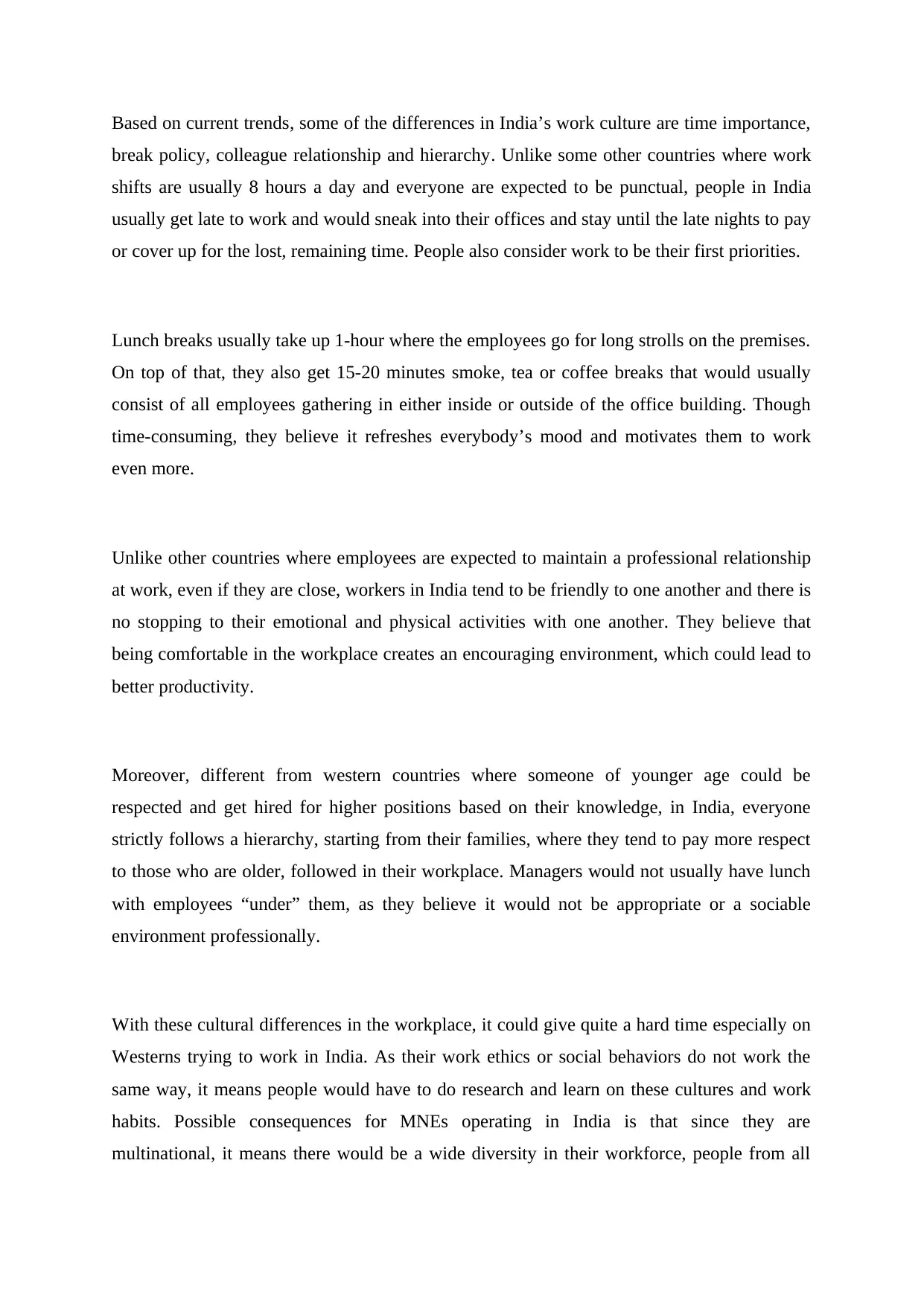
Based on current trends, some of the differences in India’s work culture are time importance,
break policy, colleague relationship and hierarchy. Unlike some other countries where work
shifts are usually 8 hours a day and everyone are expected to be punctual, people in India
usually get late to work and would sneak into their offices and stay until the late nights to pay
or cover up for the lost, remaining time. People also consider work to be their first priorities.
Lunch breaks usually take up 1-hour where the employees go for long strolls on the premises.
On top of that, they also get 15-20 minutes smoke, tea or coffee breaks that would usually
consist of all employees gathering in either inside or outside of the office building. Though
time-consuming, they believe it refreshes everybody’s mood and motivates them to work
even more.
Unlike other countries where employees are expected to maintain a professional relationship
at work, even if they are close, workers in India tend to be friendly to one another and there is
no stopping to their emotional and physical activities with one another. They believe that
being comfortable in the workplace creates an encouraging environment, which could lead to
better productivity.
Moreover, different from western countries where someone of younger age could be
respected and get hired for higher positions based on their knowledge, in India, everyone
strictly follows a hierarchy, starting from their families, where they tend to pay more respect
to those who are older, followed in their workplace. Managers would not usually have lunch
with employees “under” them, as they believe it would not be appropriate or a sociable
environment professionally.
With these cultural differences in the workplace, it could give quite a hard time especially on
Westerns trying to work in India. As their work ethics or social behaviors do not work the
same way, it means people would have to do research and learn on these cultures and work
habits. Possible consequences for MNEs operating in India is that since they are
multinational, it means there would be a wide diversity in their workforce, people from all
break policy, colleague relationship and hierarchy. Unlike some other countries where work
shifts are usually 8 hours a day and everyone are expected to be punctual, people in India
usually get late to work and would sneak into their offices and stay until the late nights to pay
or cover up for the lost, remaining time. People also consider work to be their first priorities.
Lunch breaks usually take up 1-hour where the employees go for long strolls on the premises.
On top of that, they also get 15-20 minutes smoke, tea or coffee breaks that would usually
consist of all employees gathering in either inside or outside of the office building. Though
time-consuming, they believe it refreshes everybody’s mood and motivates them to work
even more.
Unlike other countries where employees are expected to maintain a professional relationship
at work, even if they are close, workers in India tend to be friendly to one another and there is
no stopping to their emotional and physical activities with one another. They believe that
being comfortable in the workplace creates an encouraging environment, which could lead to
better productivity.
Moreover, different from western countries where someone of younger age could be
respected and get hired for higher positions based on their knowledge, in India, everyone
strictly follows a hierarchy, starting from their families, where they tend to pay more respect
to those who are older, followed in their workplace. Managers would not usually have lunch
with employees “under” them, as they believe it would not be appropriate or a sociable
environment professionally.
With these cultural differences in the workplace, it could give quite a hard time especially on
Westerns trying to work in India. As their work ethics or social behaviors do not work the
same way, it means people would have to do research and learn on these cultures and work
habits. Possible consequences for MNEs operating in India is that since they are
multinational, it means there would be a wide diversity in their workforce, people from all
Paraphrase This Document
Need a fresh take? Get an instant paraphrase of this document with our AI Paraphraser
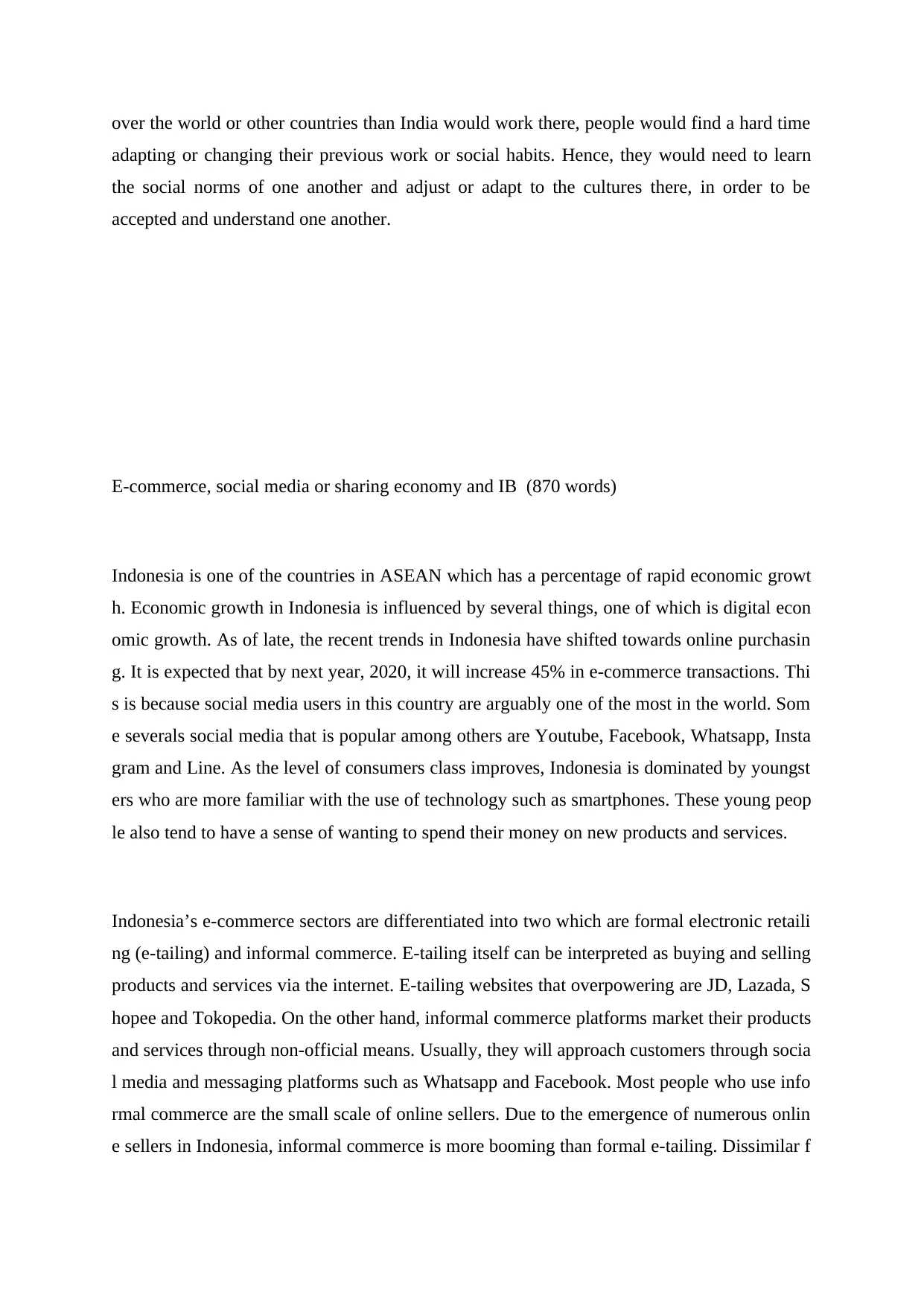
over the world or other countries than India would work there, people would find a hard time
adapting or changing their previous work or social habits. Hence, they would need to learn
the social norms of one another and adjust or adapt to the cultures there, in order to be
accepted and understand one another.
E-commerce, social media or sharing economy and IB (870 words)
Indonesia is one of the countries in ASEAN which has a percentage of rapid economic growt
h. Economic growth in Indonesia is influenced by several things, one of which is digital econ
omic growth. As of late, the recent trends in Indonesia have shifted towards online purchasin
g. It is expected that by next year, 2020, it will increase 45% in e-commerce transactions. Thi
s is because social media users in this country are arguably one of the most in the world. Som
e severals social media that is popular among others are Youtube, Facebook, Whatsapp, Insta
gram and Line. As the level of consumers class improves, Indonesia is dominated by youngst
ers who are more familiar with the use of technology such as smartphones. These young peop
le also tend to have a sense of wanting to spend their money on new products and services.
Indonesia’s e-commerce sectors are differentiated into two which are formal electronic retaili
ng (e-tailing) and informal commerce. E-tailing itself can be interpreted as buying and selling
products and services via the internet. E-tailing websites that overpowering are JD, Lazada, S
hopee and Tokopedia. On the other hand, informal commerce platforms market their products
and services through non-official means. Usually, they will approach customers through socia
l media and messaging platforms such as Whatsapp and Facebook. Most people who use info
rmal commerce are the small scale of online sellers. Due to the emergence of numerous onlin
e sellers in Indonesia, informal commerce is more booming than formal e-tailing. Dissimilar f
adapting or changing their previous work or social habits. Hence, they would need to learn
the social norms of one another and adjust or adapt to the cultures there, in order to be
accepted and understand one another.
E-commerce, social media or sharing economy and IB (870 words)
Indonesia is one of the countries in ASEAN which has a percentage of rapid economic growt
h. Economic growth in Indonesia is influenced by several things, one of which is digital econ
omic growth. As of late, the recent trends in Indonesia have shifted towards online purchasin
g. It is expected that by next year, 2020, it will increase 45% in e-commerce transactions. Thi
s is because social media users in this country are arguably one of the most in the world. Som
e severals social media that is popular among others are Youtube, Facebook, Whatsapp, Insta
gram and Line. As the level of consumers class improves, Indonesia is dominated by youngst
ers who are more familiar with the use of technology such as smartphones. These young peop
le also tend to have a sense of wanting to spend their money on new products and services.
Indonesia’s e-commerce sectors are differentiated into two which are formal electronic retaili
ng (e-tailing) and informal commerce. E-tailing itself can be interpreted as buying and selling
products and services via the internet. E-tailing websites that overpowering are JD, Lazada, S
hopee and Tokopedia. On the other hand, informal commerce platforms market their products
and services through non-official means. Usually, they will approach customers through socia
l media and messaging platforms such as Whatsapp and Facebook. Most people who use info
rmal commerce are the small scale of online sellers. Due to the emergence of numerous onlin
e sellers in Indonesia, informal commerce is more booming than formal e-tailing. Dissimilar f
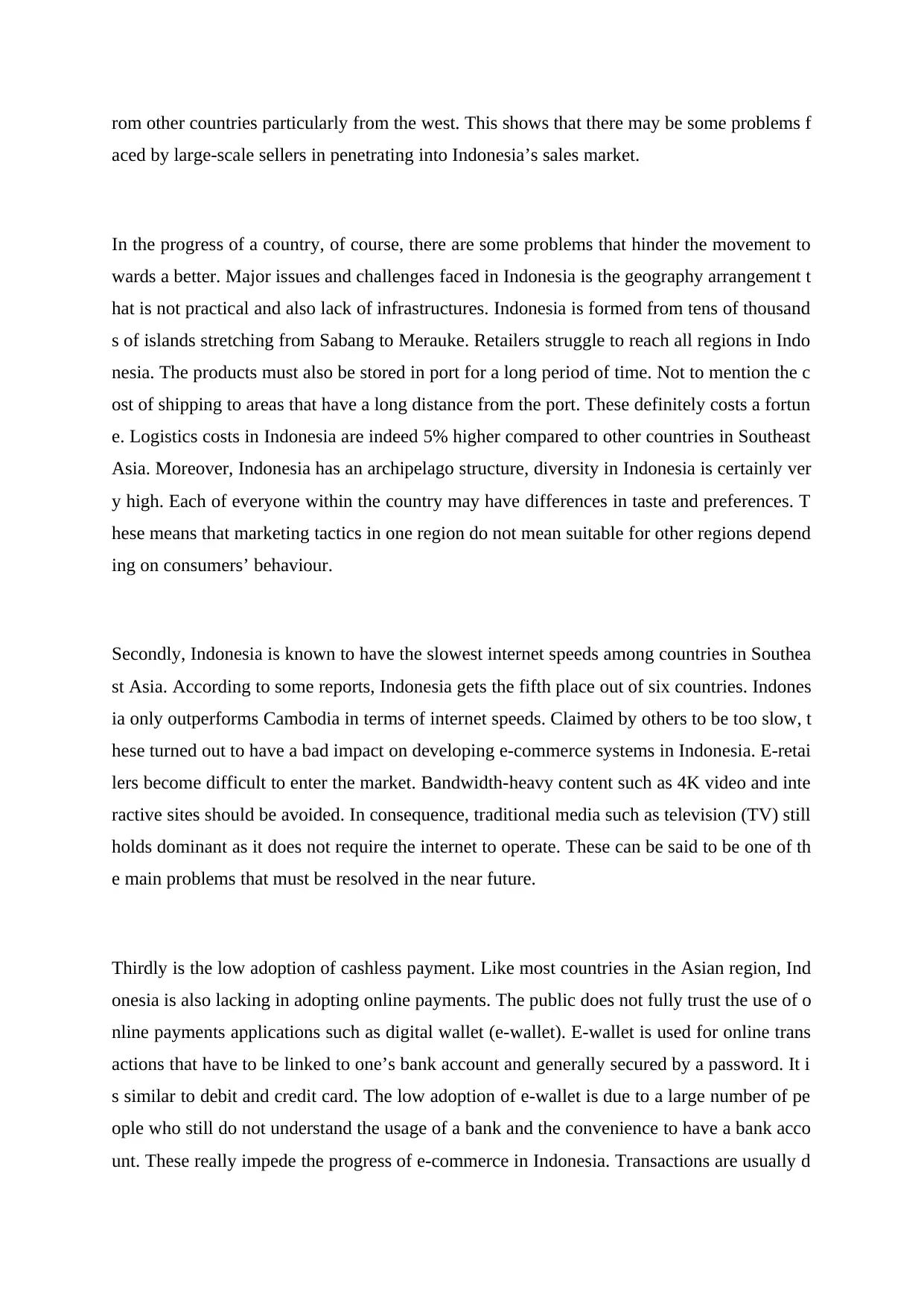
rom other countries particularly from the west. This shows that there may be some problems f
aced by large-scale sellers in penetrating into Indonesia’s sales market.
In the progress of a country, of course, there are some problems that hinder the movement to
wards a better. Major issues and challenges faced in Indonesia is the geography arrangement t
hat is not practical and also lack of infrastructures. Indonesia is formed from tens of thousand
s of islands stretching from Sabang to Merauke. Retailers struggle to reach all regions in Indo
nesia. The products must also be stored in port for a long period of time. Not to mention the c
ost of shipping to areas that have a long distance from the port. These definitely costs a fortun
e. Logistics costs in Indonesia are indeed 5% higher compared to other countries in Southeast
Asia. Moreover, Indonesia has an archipelago structure, diversity in Indonesia is certainly ver
y high. Each of everyone within the country may have differences in taste and preferences. T
hese means that marketing tactics in one region do not mean suitable for other regions depend
ing on consumers’ behaviour.
Secondly, Indonesia is known to have the slowest internet speeds among countries in Southea
st Asia. According to some reports, Indonesia gets the fifth place out of six countries. Indones
ia only outperforms Cambodia in terms of internet speeds. Claimed by others to be too slow, t
hese turned out to have a bad impact on developing e-commerce systems in Indonesia. E-retai
lers become difficult to enter the market. Bandwidth-heavy content such as 4K video and inte
ractive sites should be avoided. In consequence, traditional media such as television (TV) still
holds dominant as it does not require the internet to operate. These can be said to be one of th
e main problems that must be resolved in the near future.
Thirdly is the low adoption of cashless payment. Like most countries in the Asian region, Ind
onesia is also lacking in adopting online payments. The public does not fully trust the use of o
nline payments applications such as digital wallet (e-wallet). E-wallet is used for online trans
actions that have to be linked to one’s bank account and generally secured by a password. It i
s similar to debit and credit card. The low adoption of e-wallet is due to a large number of pe
ople who still do not understand the usage of a bank and the convenience to have a bank acco
unt. These really impede the progress of e-commerce in Indonesia. Transactions are usually d
aced by large-scale sellers in penetrating into Indonesia’s sales market.
In the progress of a country, of course, there are some problems that hinder the movement to
wards a better. Major issues and challenges faced in Indonesia is the geography arrangement t
hat is not practical and also lack of infrastructures. Indonesia is formed from tens of thousand
s of islands stretching from Sabang to Merauke. Retailers struggle to reach all regions in Indo
nesia. The products must also be stored in port for a long period of time. Not to mention the c
ost of shipping to areas that have a long distance from the port. These definitely costs a fortun
e. Logistics costs in Indonesia are indeed 5% higher compared to other countries in Southeast
Asia. Moreover, Indonesia has an archipelago structure, diversity in Indonesia is certainly ver
y high. Each of everyone within the country may have differences in taste and preferences. T
hese means that marketing tactics in one region do not mean suitable for other regions depend
ing on consumers’ behaviour.
Secondly, Indonesia is known to have the slowest internet speeds among countries in Southea
st Asia. According to some reports, Indonesia gets the fifth place out of six countries. Indones
ia only outperforms Cambodia in terms of internet speeds. Claimed by others to be too slow, t
hese turned out to have a bad impact on developing e-commerce systems in Indonesia. E-retai
lers become difficult to enter the market. Bandwidth-heavy content such as 4K video and inte
ractive sites should be avoided. In consequence, traditional media such as television (TV) still
holds dominant as it does not require the internet to operate. These can be said to be one of th
e main problems that must be resolved in the near future.
Thirdly is the low adoption of cashless payment. Like most countries in the Asian region, Ind
onesia is also lacking in adopting online payments. The public does not fully trust the use of o
nline payments applications such as digital wallet (e-wallet). E-wallet is used for online trans
actions that have to be linked to one’s bank account and generally secured by a password. It i
s similar to debit and credit card. The low adoption of e-wallet is due to a large number of pe
ople who still do not understand the usage of a bank and the convenience to have a bank acco
unt. These really impede the progress of e-commerce in Indonesia. Transactions are usually d
⊘ This is a preview!⊘
Do you want full access?
Subscribe today to unlock all pages.

Trusted by 1+ million students worldwide
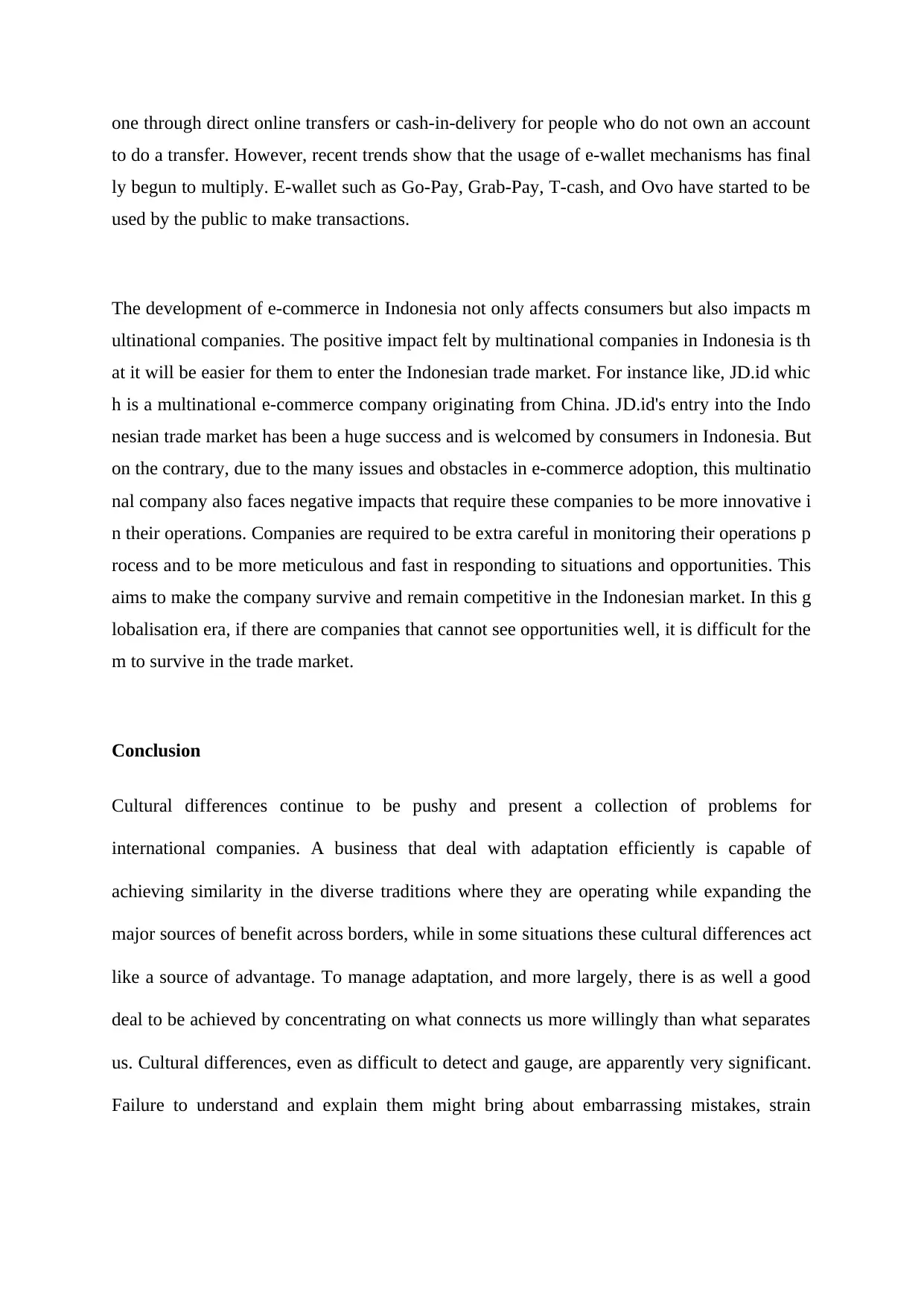
one through direct online transfers or cash-in-delivery for people who do not own an account
to do a transfer. However, recent trends show that the usage of e-wallet mechanisms has final
ly begun to multiply. E-wallet such as Go-Pay, Grab-Pay, T-cash, and Ovo have started to be
used by the public to make transactions.
The development of e-commerce in Indonesia not only affects consumers but also impacts m
ultinational companies. The positive impact felt by multinational companies in Indonesia is th
at it will be easier for them to enter the Indonesian trade market. For instance like, JD.id whic
h is a multinational e-commerce company originating from China. JD.id's entry into the Indo
nesian trade market has been a huge success and is welcomed by consumers in Indonesia. But
on the contrary, due to the many issues and obstacles in e-commerce adoption, this multinatio
nal company also faces negative impacts that require these companies to be more innovative i
n their operations. Companies are required to be extra careful in monitoring their operations p
rocess and to be more meticulous and fast in responding to situations and opportunities. This
aims to make the company survive and remain competitive in the Indonesian market. In this g
lobalisation era, if there are companies that cannot see opportunities well, it is difficult for the
m to survive in the trade market.
Conclusion
Cultural differences continue to be pushy and present a collection of problems for
international companies. A business that deal with adaptation efficiently is capable of
achieving similarity in the diverse traditions where they are operating while expanding the
major sources of benefit across borders, while in some situations these cultural differences act
like a source of advantage. To manage adaptation, and more largely, there is as well a good
deal to be achieved by concentrating on what connects us more willingly than what separates
us. Cultural differences, even as difficult to detect and gauge, are apparently very significant.
Failure to understand and explain them might bring about embarrassing mistakes, strain
to do a transfer. However, recent trends show that the usage of e-wallet mechanisms has final
ly begun to multiply. E-wallet such as Go-Pay, Grab-Pay, T-cash, and Ovo have started to be
used by the public to make transactions.
The development of e-commerce in Indonesia not only affects consumers but also impacts m
ultinational companies. The positive impact felt by multinational companies in Indonesia is th
at it will be easier for them to enter the Indonesian trade market. For instance like, JD.id whic
h is a multinational e-commerce company originating from China. JD.id's entry into the Indo
nesian trade market has been a huge success and is welcomed by consumers in Indonesia. But
on the contrary, due to the many issues and obstacles in e-commerce adoption, this multinatio
nal company also faces negative impacts that require these companies to be more innovative i
n their operations. Companies are required to be extra careful in monitoring their operations p
rocess and to be more meticulous and fast in responding to situations and opportunities. This
aims to make the company survive and remain competitive in the Indonesian market. In this g
lobalisation era, if there are companies that cannot see opportunities well, it is difficult for the
m to survive in the trade market.
Conclusion
Cultural differences continue to be pushy and present a collection of problems for
international companies. A business that deal with adaptation efficiently is capable of
achieving similarity in the diverse traditions where they are operating while expanding the
major sources of benefit across borders, while in some situations these cultural differences act
like a source of advantage. To manage adaptation, and more largely, there is as well a good
deal to be achieved by concentrating on what connects us more willingly than what separates
us. Cultural differences, even as difficult to detect and gauge, are apparently very significant.
Failure to understand and explain them might bring about embarrassing mistakes, strain
Paraphrase This Document
Need a fresh take? Get an instant paraphrase of this document with our AI Paraphraser
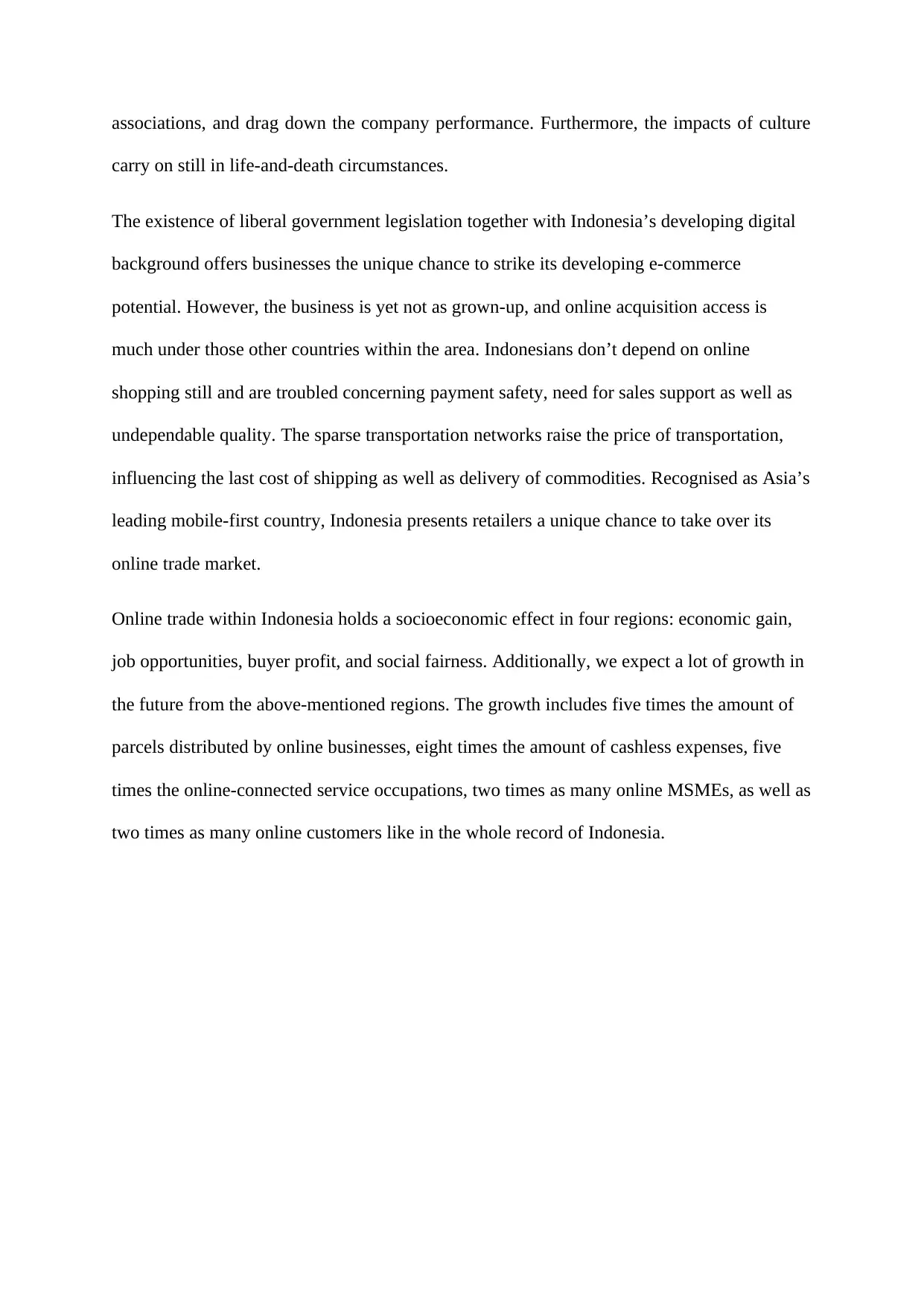
associations, and drag down the company performance. Furthermore, the impacts of culture
carry on still in life-and-death circumstances.
The existence of liberal government legislation together with Indonesia’s developing digital
background offers businesses the unique chance to strike its developing e-commerce
potential. However, the business is yet not as grown-up, and online acquisition access is
much under those other countries within the area. Indonesians don’t depend on online
shopping still and are troubled concerning payment safety, need for sales support as well as
undependable quality. The sparse transportation networks raise the price of transportation,
influencing the last cost of shipping as well as delivery of commodities. Recognised as Asia’s
leading mobile-first country, Indonesia presents retailers a unique chance to take over its
online trade market.
Online trade within Indonesia holds a socioeconomic effect in four regions: economic gain,
job opportunities, buyer profit, and social fairness. Additionally, we expect a lot of growth in
the future from the above-mentioned regions. The growth includes five times the amount of
parcels distributed by online businesses, eight times the amount of cashless expenses, five
times the online-connected service occupations, two times as many online MSMEs, as well as
two times as many online customers like in the whole record of Indonesia.
carry on still in life-and-death circumstances.
The existence of liberal government legislation together with Indonesia’s developing digital
background offers businesses the unique chance to strike its developing e-commerce
potential. However, the business is yet not as grown-up, and online acquisition access is
much under those other countries within the area. Indonesians don’t depend on online
shopping still and are troubled concerning payment safety, need for sales support as well as
undependable quality. The sparse transportation networks raise the price of transportation,
influencing the last cost of shipping as well as delivery of commodities. Recognised as Asia’s
leading mobile-first country, Indonesia presents retailers a unique chance to take over its
online trade market.
Online trade within Indonesia holds a socioeconomic effect in four regions: economic gain,
job opportunities, buyer profit, and social fairness. Additionally, we expect a lot of growth in
the future from the above-mentioned regions. The growth includes five times the amount of
parcels distributed by online businesses, eight times the amount of cashless expenses, five
times the online-connected service occupations, two times as many online MSMEs, as well as
two times as many online customers like in the whole record of Indonesia.

⊘ This is a preview!⊘
Do you want full access?
Subscribe today to unlock all pages.

Trusted by 1+ million students worldwide
1 out of 12
Related Documents
Your All-in-One AI-Powered Toolkit for Academic Success.
+13062052269
info@desklib.com
Available 24*7 on WhatsApp / Email
![[object Object]](/_next/static/media/star-bottom.7253800d.svg)
Unlock your academic potential
Copyright © 2020–2025 A2Z Services. All Rights Reserved. Developed and managed by ZUCOL.





